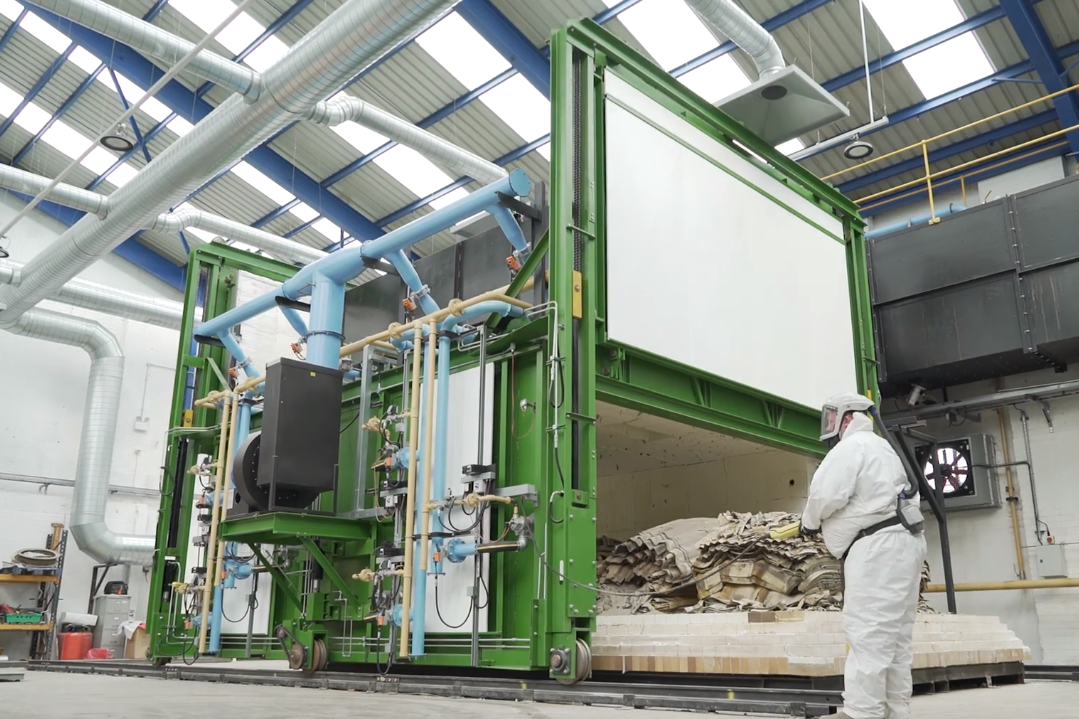
A recycling business has devised a process for converting asbestos into a new material that can be used safely as a construction product.
Thermal Recycling, which opened a demonstration plant last month, says it is the first company in the world to offer an environmentally responsible alternative to landfill disposal of the deadly material.
The Wolverhampton-based treatment facility converts cement roof sheets containing chrysotile asbestos, which account for around 60% of asbestos taken to landfill, according to Thermal Recycling chairman Graham Gould.
“Thermal treatment changes the chemical and physical composition of the asbestos,” he said. “The asbestos-free substance left over, which contains calcium, aluminium and magnesium (as silicates, carbonates, sulphates and oxides) and has been dubbed ‘Calmag’, is then crushed for use a building material.”
Gould, who has been working on the project for a decade, says the process follows Environment Agency (EA) protocols.
“We used EA methodology to produce a sampling plan, and analysed 350 samples, which showed that the substance created by the process has achieved ‘end of waste status’, which means it is no longer classed as waste and can be a product,” Gould explained. “We have also registered it with the European Chemicals Agency. “The testing was carried out at the and Health & Safety Executive’s commercial laboratory in Buxton, which is recognised as the ‘gold standard’ for testing of asbestos.”

Gould says Thermal Recycling has identified roads and roofing – following discussions with the National Federation of Roofing Contractors (NFRC) – as potential uses for the Calmag material.
“We have received a £65,000 ‘smart’ grant from Innovate UK to investigate other potential uses for the product in the construction industry,” he added.
Gould says the conversion process can be run on an industrial scale, and he plans to expand Thermal Recycling with a network of plants around the UK.
Kevin Taylor, president of the NFRC and managing director of BRC Roofing, said: “The NFRC welcomes this leading-edge technology with the potential for a more sustainable approach to the disposal of asbestos. It is vital that we divert waste from landfill and reduce the number of sites containing asbestos.”
Asbestos is responsible for the deaths of around 5,000 workers each year. Around 20 tradesmen die each week as a result of past exposure to asbestos. Asbestos can be found in any building built in the UK before the year 2000, including houses, factories, offices, schools and hospitals. Currently asbestos waste has to be disposed of by a registered waste carrier at a licensed disposal site.
Comments
Comments are closed.











This is a remarkable achievement and has potential applications around the world, Alan
It sound fantastic, good luck for the future. It may have come to late for some but future generation will benefit greatly from all your en-devours and hard work.
Kind Regards
Alan Needle
At last, as an Asbestos surveyor, someone has found a use for this material in my lifetime. Brilliant initiative, all news is not doom and gloom
Given that this ‘Calmag’ is silicates, carbonates, sulphates and oxides. What precautions are required when it becomes friable in use as a building material e.g. being sawn cut or drilled into?
I think a lot more research needs to go into this product before being released into the built environment (again). Too many people have respiratory disease due to the use of asbestos in various forms (myself included).
I know that the danger from asbestos comes from the physical form of the fibres, combined with the chemical inertness that prevents the body breaking it down – the irritation creates the condition for cancer.
This seems a great idea if it can work commercially – but the handling would need to be careful to not cross contaminate the ‘calmag’ with asbestos fibres from the next batch?
great idea
will the asbestos waste (old roof sheets etc) be taken to the plant by the current asbestso skip providers
Regards
Gary Lane